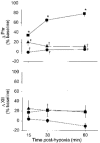Episodic but not continuous hypoxia elicits long-term facilitation of phrenic motor output in rats
- PMID: 11080263
- PMCID: PMC2270180
- DOI: 10.1111/j.1469-7793.2000.00215.x
Episodic but not continuous hypoxia elicits long-term facilitation of phrenic motor output in rats
Abstract
1. Intermittent hypoxia elicits long-term facilitation (LTF) of phrenic motor output in anaesthetized rats. We tested the hypothesis that an equal cumulative duration of continuous hypoxia would not elicit phrenic LTF. 2. Integrated phrenic nerve activity was recorded in urethane-anaesthetized, vagotomized, paralysed and ventilated rats exposed to: (1) 3 X 3 min hypoxic episodes (inspired O2 fraction (FI, O2) = 0.11) separated by 5 min hyperoxia (FI,O2 = 0.5; n = 6), (2) 9 min continuous hypoxia (n = 6), or (3) 20 min continuous hypoxia (n = 7). Isocapnia was maintained throughout the protocol. 3. Consistent with previous studies, phrenic amplitude was significantly elevated for at least 1 h following intermittent hypoxia (78 +/- 15% 60 min post-hypoxia; P < 0.05) with an associated increase in burst frequency (11 +/- 2.1 bursts min-1; P < 0.05). In contrast, 9 or 20 min continuous hypoxia did not elicit LTF of either phrenic amplitude (4.7 +/- 5.1 and 10.1 +/- 10.2% 60 min post-hypoxia, respectively; P > 0.05) or frequency (4.6 +/- 1.3 and 5.1 +/- 2 bursts min-1 60 min post-hypoxia, respectively; P > 0.05). 4. The results indicate that hypoxia-induced long-term facilitation of phrenic motor output is sensitive to the pattern of hypoxic exposure in anaesthetized rats.
Figures



References
-
- Bach KB, Kinkead R, Mitchell GS. Post-hypoxia frequency decline in rats: sensitivity to repeated hypoxia and alpha2-adrenoreceptor antagonism. Brain Research. 1999;817:25–33. - PubMed
-
- Bach KB, Mitchell GS. Hypoxia-induced long-term facilitation of respiratory activity is serotonin dependent. Respiration Physiology. 1996;104:251–260. - PubMed
-
- Bisgard GE, Neubauer JA. Peripheral and central effects of hypoxia. In: Dempsey JA, Pack AI, editors. Regulation of Breathing. New York: Marcel Dekker; 1995. pp. 617–618.
-
- Carew TJ, Pinsker HM, Kandel ER. Long-term habituation of a defensive withdrawal reflex in Aplysia. Science. 1972;175:451–454. - PubMed
Publication types
MeSH terms
Substances
Grants and funding
LinkOut - more resources
Full Text Sources
Miscellaneous

